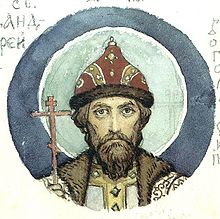Andrey Bogolyubsky
Andrei Bogolyubsky | |
|---|---|
 Russian icon of Saint Andrei Bogolyubsky | |
| Passion Bearer | |
| Born | c. 1111 |
| Died | June 28, 1174 (aged 62/63) |
| Venerated in | Eastern Orthodox Church |
| Major shrine | Dormition cathedral, Vladimir |
| Feast | June 30, July 4 (burial) |
| Attributes | Clothed as a Russian Grand Prince, holding a three-bar cross in his right hand |
Andrei I Yuryevich, commonly known under his sobriquet Andrei the Pious (Russian: Андрей Боголюбский) (c. 1111 – June 28, 1174), was Grand prince of Vladimir-Suzdal from 1157 until his death. His reign saw a complete decline of Kiev's rule over northeastern Rus, and the rise of Vladimir as the new capital city. Andrei was known in the West as Scythian Caesar, and is canonized as a saint in the Russian Orthodox Church.[1]
Life[]

He was the son of Yuri Dolgoruki,[2] who proclaimed Andrei a prince in Vyshgorod (near Kiev). His mother was a Polovtsian (Cuman) princess, khan Aepa's/Ayepa's daughter.
Andrei left Vyshgorod in 1155 and moved to Vladimir. After his father's death (1157), he became Knyaz (prince) of Vladimir, Rostov and Suzdal.[1]
Andrey Bogolyubsky tried to unite Rus' lands under his authority. From 1159 he persistently struggled for submission of Novgorod to his authority and conducted a complex military and diplomatic game in South Rus. In 1162, Andrey Bogolyubsky sent an embassy to Constantinople, lobbying for a separate metropolitan see in Vladimir. In 1169 his troops sacked Kiev, devastating it as never before.[3][4] After plundering the city,[5] stealing much religious artwork, which included the Byzantine "Mother of God" icon.[6] Andrei appointed his brother Gleb as prince of Kiev, in an attempt to unify his lands with Kiev.[7] Following his brother's death in 1171, Andrei became embroiled in a two-year war to maintain control over Kiev, which ended in his defeat.[7]
Andrei achieved the right to receive a tribute from the population of the Northern Dvina land. Becoming "ruler of all Suzdal land", Andrei Bogolyubsky transferred his capital to Vladimir, strengthened it and constructed the magnificent Assumption Cathedral,[2] the Church of the Intercession on the Nerl,[8] and other churches and monasteries. Under his leadership Vladimir was much enlarged, and fortifications were built around the city.[9]
At the same time the castle Bogolyubovo was built next to Vladimir, and was a favorite residence of his.[9] In fact he received his nickname "Bogolyubsky" in honor of this place. It was he who brought the Theotokos of Vladimir to the city whose name it now bears. During Andrei Bogolyubsky's reign the Vladimir-Suzdal principality attained significant power and was the strongest among the Rus' principalities.[citation needed]
Amplification of princely authority and conflict with outstanding boyars was the cause of a plot against Andrei Bogolyubsky, as a result of which he was killed on the night of June 28 to June 29, 1174.[6] Twenty of his disgruntled retainers burst into his chambers and slew Andrei in his bed.[6] His silver-inlaid war axe can now be viewed at the State Historical Museum in Moscow.
His son, Yuri Bogolyubsky, was the first husband of Queen Tamar of Georgia. An ancient icon, Theotokos of Bogolyubovo was painted at the request of Andrey Bogolyubsky.[10]
References[]
- ^ Jump up to: a b Andrew I at the Encyclopædia Britannica
- ^ Jump up to: a b Brumfield, William Craft (2013). Landmarks of Russian Architecture. Routledge. pp. 1–2. ISBN 9781317973256.
- ^ Plokhy, Serhii (2006), The Origins of the Slavic Nations (PDF), Cambridge University Press, p. 42, ISBN 9780521864039, archived from the original (PDF) on March 29, 2017
- ^ Martin, Janet (2004) [1986]. Treasure of the Land of Darkness: The Fur Trade and Its Significance for Medieval Russia. Cambridge University Press. p. 127. ISBN 9780521548113.
- ^ "Russian Rulers: Andrey Yurievich Bogolyubsky", Russia the Great, retrieved August 7, 2007
- ^ Jump up to: a b c Martin, Janet (1995). Medieval Russia: 980-1584. Cambridge University Press. p. 100. ISBN 9780521368322.
- ^ Jump up to: a b Pelenski, Jaroslaw (1988). "The Contest for the "Kievan Succession" (1155-1175): The Religious-Ecclesiastical Dimension". Harvard Ukrainian Studies. 12/13: 776. JSTOR 41036344.
- ^ Shvidkovskiĭ, Dmitriĭ Olegovich (2007). Russian Architecture and the West. Yale University Press. p. 36. ISBN 9780300109122.
- ^ Jump up to: a b Martin (1995), p. 84.
- ^ ""Bogolyubov" Icon of the Mother of God". Orthodox Church in America. Retrieved 22 June 2021.
External links[]
- Burial of St Andrew the Prince Orthodox icon and synaxarion
- 1110s births
- 1174 deaths
- 12th-century murdered monarchs
- Eastern Orthodox royal saints
- Grand Princes of Vladimir
- Russian saints of the Eastern Orthodox Church
- Rurik dynasty
- Yurievichi family
- Murdered Russian monarchs
- Burials at Dormition Cathedral, Vladimir
- People of Cuman descent